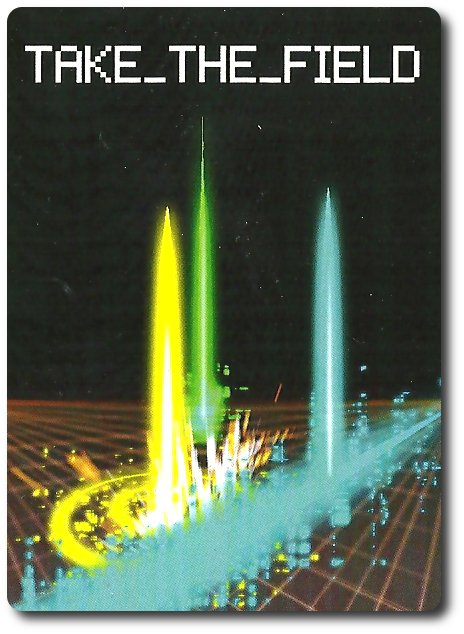
The Basics:
- For ages 10 and up (publisher suggests 12+)
- For 2 to 4 players
- Approximately 60 minutes to complete
Geek Skills:
- Counting & Math
- Logical & Critical Decision Making
- Strategy & Tactics
- Worker Placement & Area Control
Learning Curve:
- Child – Moderate
- Adult – Easy
Theme & Narrative:
- DESTROY YOUR ENEMY WITH MATH!!!
Endorsements:
- Gamer Geek mixed!
- Parent Geek approved!
- Child Geek mixed!
Overview
When you get right down to it, a computer is nothing more than a calculator. How it processes commands and renders graphics can be broken down into equations that involve zero’s and one’s. A computer virus takes advantage of this, finding holes in mathematical formulas that allow it to break in and take over. In this game, math is your weapon. With it, you can do critical damage.
Take the Field, developed by Colmena Design and published via the Game Crafter, is comprised of 1 game board, 400 Player tokens (100 per color), 1 standard six-sided die (with pips), 1 standard six-sided die (with numbers), and 44 Action cards. The game board is solid and folds out to create an 18″ x 18″ playing area. The Action cards are as thick and as durable as your standard playing card. The Player tokens are circular pips, which are made out of plastic.
![]()
Take the Field was created by a group of young designers. The intent of the games they design are to enrich and educate. This and other games designed by them are available for free at www.hostosgfms.com.
Virus Detected
Note: The game set up described here is for a 4-player game.
To set up the game, first place the game board in the middle of the playing area. All players should be able to easily reach any section of the game board from where they are sitting.
Second, hand to each player their Player tokens, which should be the same color.
Third, shuffle the Action cards and deal 5 to each player, face-down. Place the remaining deck of Action cards face-down to one side of the game board. This is the draw deck for the duration of the game.
That’s it for game set up. Determine who will go first and begin.
Mathematical Apocalypse
Take the Field is played in rounds and turns. A single game consists of no more than 5 rounds of game play. A player’s turn is summarized here.
Step 1: Roll Dice
The active player rolls the 2 six-sided dice. While the values on the die may be the same, as will the range of number values, the number display is important. The six-sided die showing a number value will be used differently than the six-sided die showing a number of pips.
Step 2: Play One Action Card
Each Action card displays an equation that must be completed using the dice rolled by the active player during their step 1. The die showing number values as pips is represented by the circle in the equation found on the cards. The die showing number values is represented by the square. The Action card will direct the player to either choose the “y” or “x” value of the equation, isolating a variable. Other Action cards will only require the active player solve for “y” or “x”. All all cases, the die values are used and the resulting “x” and “y” values either represent a number or a location on a grid (found on the game board).
Selecting the right Action card is important, as the mathematical outcome of the equation determines how many Player tokens the action player can place on their turn and how. Each of the Action card types are summarized here.
Seize
This Action card allows the player to plot an axis using 2 equations. The value will determine where the player can place a Player token.
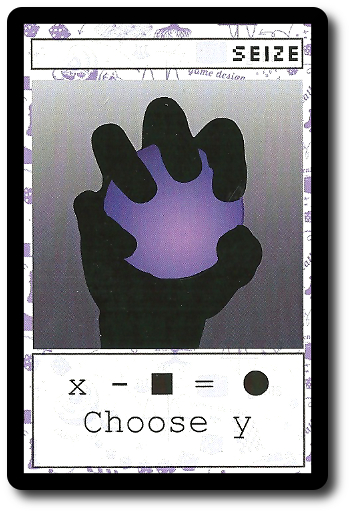
Shield
This Action card provides the player the ability to take a larger chunk of the game board by plotting a pair of axis points and then placing Player tokens in the spaces between them.

Wall
This Action card is similar to the “Shield” Action card, but the resulting solved equation will allow the player to place Player tokens on an entire row or column of the game board.
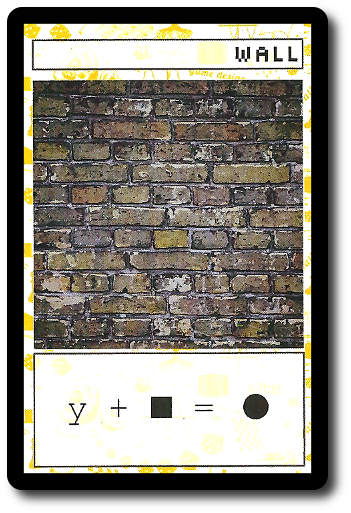
Pulse
This Action card allows the active player to grab a square area of the game board using 9 or 16 Player tokens.

Annul
This Action card interrupts an opponent’s action prior to it being completed. While a worthwhile defensive action, it will cost the player their next turn.
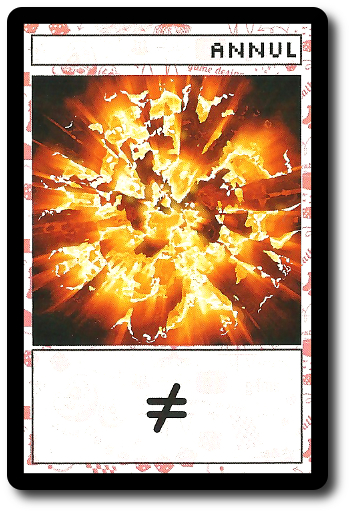
If an opponent’s Player token is occupying a space the active player wants to use, the opponent’s Player token is removed.
Step 3: End of Turn
The active player’s turn is now over. The Action card used is placed on the bottom of the Action card draw deck. Then the active player draws the top-most card, adding it to their hand.
The dice are then passed to the opponent on the active player’s left. After all players have completed a turn, the round ends and a new round begins.
Dividing by Zero
The game continues until the last turn is taken and round 5 ends. Players then count the number of Player tokens in each quadrant, multiplying the total per the quadrant’s noted multiplication factor. Any Player tokens on the “x” or “y” zero position receive 1 point and do not belong to any of the quadrants.
The player first determines the values for each quadrant separately and then adds the 4 quadrant values together to determine their final score. The player with the highest score wins the game.
To learn more about Take the Field, visit the game’s web page.
Final Word
The Child Geeks were not big fans of the game. Many of them feel that math is a legal form of torture. Which is not to say they cannot play the game. It’s more like they didn’t want to. According to one Child Geek, “If you told me this game was about being a computer virus and taking over a computer, I’d play that. But you said it was a game that uses math to take over spaces. That sounds horrible.” No matter how we spun the game, the Child Geeks always sniffed out the game’s true nature. For those who enjoyed math, they found the game to be entertaining, but not overly exciting. As one Child Geek put it, “I wouldn’t play this game at home, but I think it would be a lot of fun at school.” Playing the game at school in a classroom setting seemed to be the majorities suggestion. On the family gaming table, it was too close to homework. At school, it was an opportunity to use the lessons they learned using alternative means to demonstrate their skills. The Child Geeks gave Take the Field a mixed level of approval.
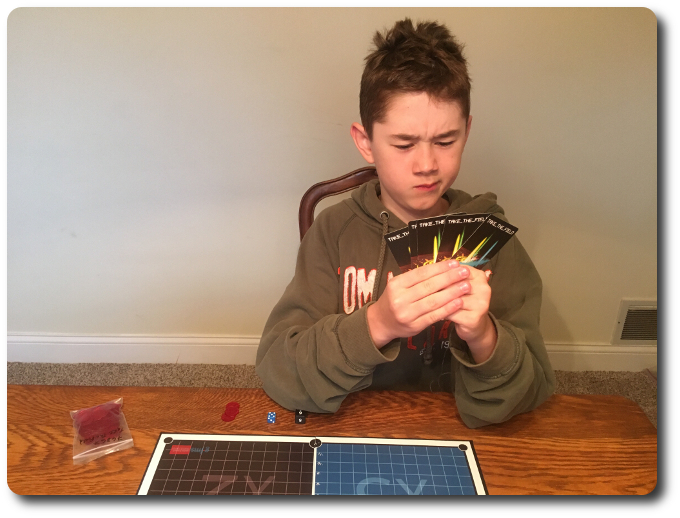
The easiest part of the game is rolling the dice…
The Parent Geeks, amusingly enough, had to refresh their mathematical knowledge in order to play the game. According to one Parent Geek, “You know, when you don’t use it, you tend to lose it.” After the Parent Geeks felt comfortable enough to play the game without the constants need to look up information using the internet, they got into the swing of things. As one Parent Geek put, “I’m enjoying the game now, but I’m not really getting into it. It’s well designed, but I don’t feel like I’m doing much other than solving math problems.” Which was part of the problem the Child Geeks identified. At home, Take the Field felt like work instead of fun. When the game was given to teacher to attempt, he reported back that the game was very well received by his class and peers. According to the Teacher Parent Geek, “Games like this reinforce the basics and demonstrate how they can be used to effect outcomes. It’s a powerful educational tool and a lot of fun.” When the games were over, the Parent Geeks decided to approve the game for its educational value.
The Gamer Geeks were pretty sure they saw a game similar to Take the Field on their computers back in the day when everything used floppy disks. According to one Gamer Geek, “The game isn’t doing anything new here, but I like how it is doing it. My biggest complaint is that the cards are too minimal and you have to spend too much time looking up what cards do. The game is not difficult, but lack of solid instructions and information make it a bit clumsy.” Other players felt the same way, but everyone quickly learned. Another Gamer Geek said, “I think this is a great example of a teaching tool, but not a game I would want to play on my free time.” And one other Gamer Geek said, “Easy to understand and it requires a lot of thought to win. I like the concept and its execution. This would be a great game for teachers and students.” When the games were over, the Gamer Geeks decided to give Take the Field a mixed level of approval, finding it to be well designed, but not a game they would want to play on their own.
Take the Field is an excellent example of gamification. It takes the process of learning mathematics and turns it into a game, but there is a bit more to it than that. While it’s most certainly necessary to solve the equations on the Action cards, a player must also consider which Action card to use and where to place their Player tokens. In this way, Take the Field is not just an exercise in mathematical might. Players must also strategize, logically think through their moves, and critically consider all of their options.
At no time is a player pushed into a corner. There is always something they can do. What will hold them back is their current level of mathematical understanding and comfort level. For our younger players, some of the equations looked like a mix of Sanskrit and Latin. Some of our adults even had to pause and ask for help, having not used a number of the equations for years. Luckily for everyone, the game is meant to educate as well as challenge. There is nothing stopping a player from asking for help. Once you learn how the equations are solved, it’s just a matter of remembering, since the math uses small numbers.
Game wise, Take the Field feels more like a fun mathematical exercise rather than a game. A great deal of emphasis is placed on the Action cards and the equation the player has to solve. Player interaction is limited to the “Annul” Action card and bumping an opponent’s Player tokens off the game board. The most hotly contested portion of the game will be the quadrants that have the highest multiplier, but any player interaction found there is due to limited space. As such, the game does feel like a competition, but not all the time.
As a teaching aid, reinforcement exercise, and excuse to play board games in the classroom, Take the Field is brilliant. The random dice values always change the values to be used and the Action cards decide the formula the values will be plugged into. Individuals who can complete mathematical formulas in their head quickly do not have an advantage here. The goal is to become comfortable with the the mathematical formulas being used, seeing how they physically interact with the game board, and leveraging them to control large sections of the grid and quadrants. It’s command and conquer with math. Instead of warriors and weapons, dice and formulas are used.
Take the Field is not a game I would suggest be played on my gaming table, but it’s a game I would want to have around the house to help my children (and myself) strengthen and reinforce their mathematical skills. It’s also a game I could see being used in classrooms and after school groups. That game is fun and challenging, making no attempted to disguise the fact that it’s all about math. That will turn off some, but the game play certainly won’t. A tremendous feeling of accomplishment washes over you when you not only solve for “x”, but get to place a lot of Player tokens down as a result of your awesome mathematical skills. Do play Take the Field and see if it adds up to something positive for you and yours.
This game was given to Father Geek as a review copy. Father Geek was not paid, bribed, wined, dined, or threatened in vain hopes of influencing this review. Such is the statuesque and legendary integrity of Father Geek.



